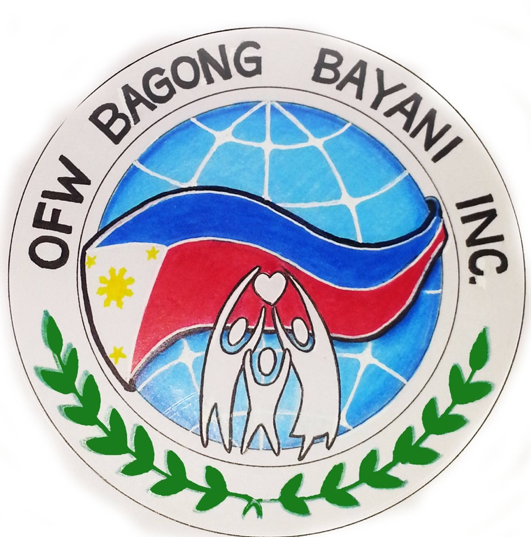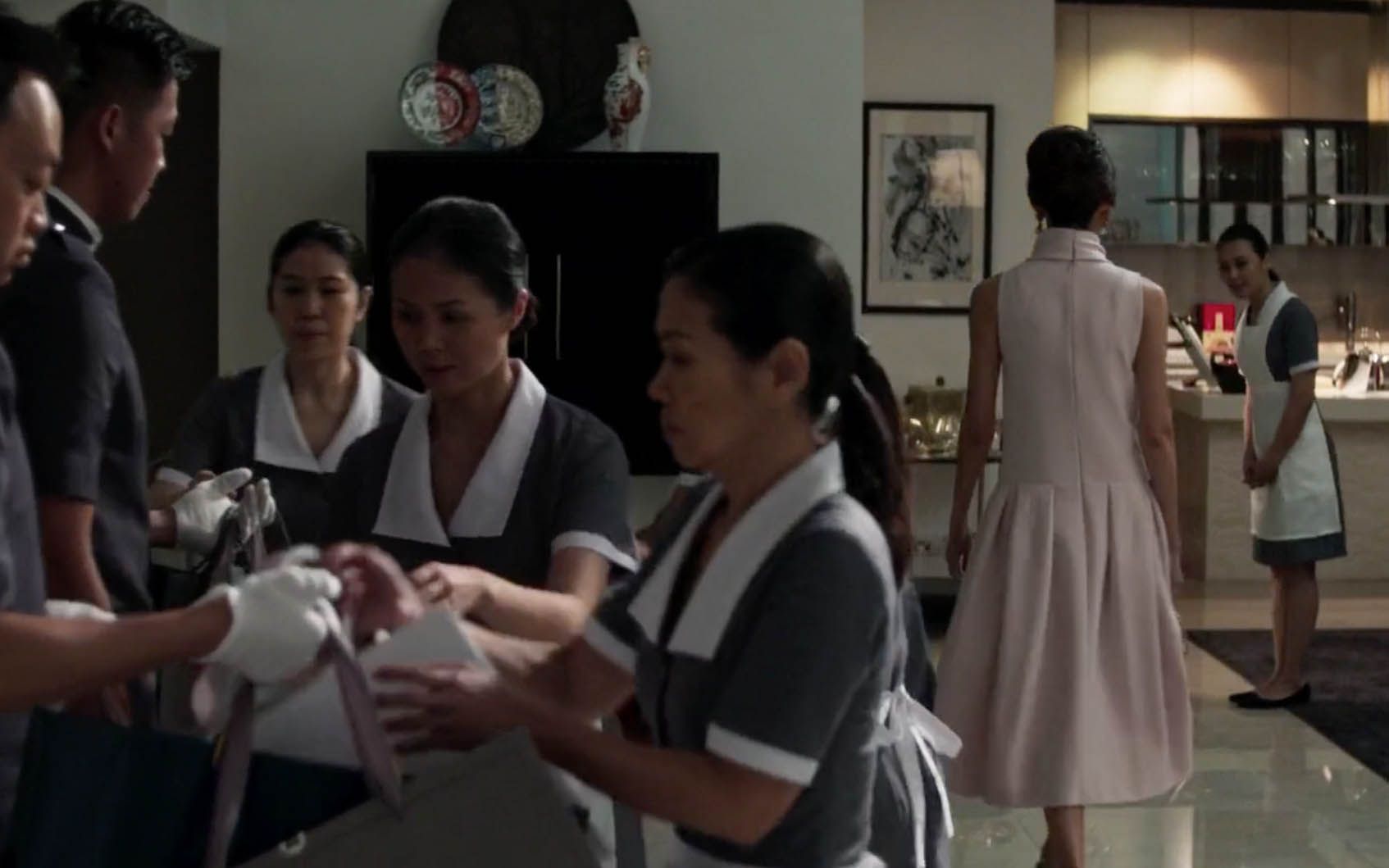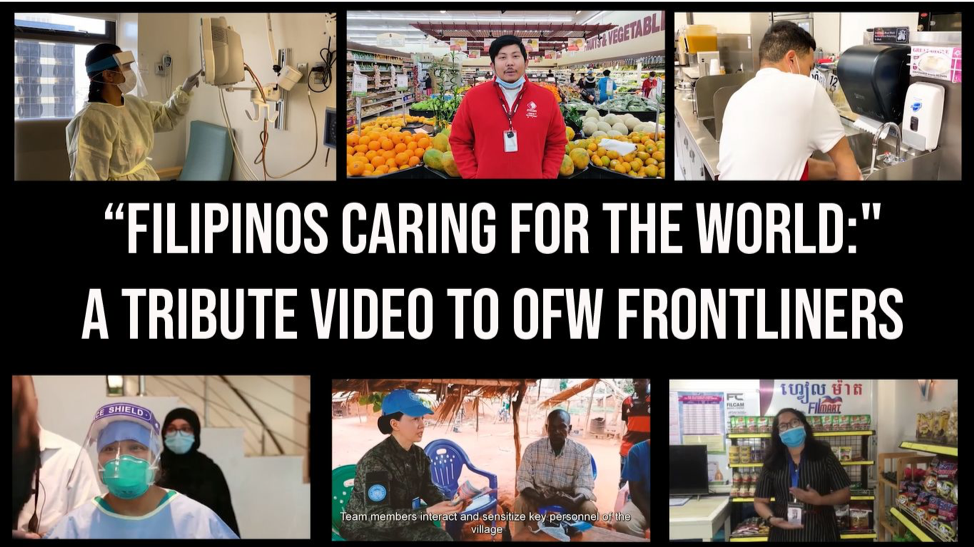Banner photo: Junji Delfino and other uncredited actors portraying Filipino domestic workers in Hong Kong, the only Filipino characters in Crazy Rich Asians (2018).
Special thanks to GABRIELA New York and Anakbayan Manhattan for facilitating an educational discussion on Philippine labor export policies.
The COVID-19 pandemic brings to light not only medical racism in the United States, but also the continued intersection of gender and labor. In tandem with the “brain drain” of Filipino professionals is the “care drain,” as the Philippines sought to address unemployment by exporting their own workers, many of whom are young Filipino women. Such migrant workers have been lauded as the “national heroes,” which goes against the typical definition of a “hero.” Rather than having any superpowers, Filipino migrant workers instead work precarious jobs outside of the public eye, in the domestic sphere, and at the mercy of foreign employers and labor laws. The number of Pinays (Filipino women) who have died while working abroad is staggering. However, rather than adequately addressing the femicide of Pinay migrant workers, the Philippines instead continued to export labor up until the COVID-19 pandemic. Considering how the pandemic has already contributed to the deaths of several Filipino healthcare workers, we also mourn the deaths of Pinay OFWs who have been “deployed” to dangerous workplaces around the world for the past 45 years.
Whereas Filipino women are stereotyped as nurses in the United States, they are instead stereotyped as “helpers” or domestic workers in other countries such as Canada and Hong Kong. As of 2019, there are about 2.2 million Filipino migrant workers, 56% of whom are women. They’re also disproportionately younger, with 53.9% of Pinay migrant workers being under the age of 35 according to the Philippine Statistics Authority.
What does it mean for Pinay migrant workers to leave the domestic sphere in their home country and home province, only to do domestic work for white and light-skinned families around the world? Although the US has historically played a role in Filipino migration and gender dynamics, labor export policies in the Philippines have exacerbated the rise of Pinay migrant workers worldwide. This is important because Pinay migrant workers are particularly in danger due to the lack of labor protections, with many of them working as domestic workers and frontline workers during the COVID-19 pandemic. This pandemic only adds on to the femicide that’s already happening as a result of exporting thousands of Pinay migrant workers.
Historical Context
Although laborers have traveled from the present-day Philippines to present-day North America for centuries due to Spanish and US imperialism, the Philippines has actively promoted the rise of Filipino migrant labor since the mid-1970s. US-backed Filipino dictator Ferdinand Marcos initially established the Philippine Labor Migration Policy (Labor Export Policy) in 1974 as an attempt to address unemployment in the Philippines. However, it also created government agencies that would broker recruitment of Filipino contract workers to other countries. In 1982, the Philippine Overseas Employment Administration (POEA) and Overseas Workers Welfare Administration (OWWA) were established to promote and monitor the overseas employment of Filipino migrant workers and collect fees from migrant workers respectively.
As the Philippines began to export labor, it began to import material goods and remittances from its own laborers. Under Corazon Aquino’s leadership, Executive Order 206 was enacted in 1987 to allow tax-free entry of personal goods sent to the Philippines through balikbayan boxes, cargo-sized cardboard boxes of six cubic feet. The word balikbayan has root words meaning “return” and “country,” so although the word translates as “repatriate,” instead the existence of balikbayan boxes implies the “return” of material goods rather than Filipino people. In 1989, the Balikbayan Program was established to promote the return of OFWs and other Filipino expatriates to the Philippines through travel tax exemption and visa-free entry. However, this version of “returning” is temporary, and it actively encourages OFWs and their spouses and/or children to shop and bring even more material goods to the Philippines.

Despite the increasing publicity of women OFWs being subject to violence while on the job, the number of OFWs has grown exponentially and has become increasingly female. In 1995, following the murder of a domestic worker in Singapore named Flor Contemplacion, the Philippines enacted the Migrant Workers Act. Under the guise of assuring dignity and fundamental rights for OFWs however, the Migrant Workers Act of 1995 instead increased government profits while removing their liability of migrant workers. In the same year, the Philippines also ratified the Mining Act of 1995 in an attempt to boost the economy. This unfortunately allowed foreign ownership of Philippine mineral reserves, leading to a 400% increase in foreign mining companies between 1994 and 1996.
The Fabrication of Migrant Work as Nationalistic Heroism: OFWs and Bagong Bayani
Considering this history of Filipino migrant workers, it is important to note that the terminology has changed over time. When Philippine labor export policies were first created in the mid-1970s, migrant workers were known as Overseas Contract Workers (OCWs). However, in the 1990s with the passing of the Migrant Workers Act, Filipino migrant workers became known as Overseas Filipino Workers (OFWs). The term OFW was officially adopted by the Philippine government in 2002, when the Philippine Overseas Employment Administration (POEA) updated its rules and regulations. It is telling that the Philippines labels its own migrant workers as Overseas Filipino Workers, whereas its current authoritarian leader Rodrigo Duterte considers other members of the diaspora such as Filipino Americans to be “not Filipino.”
Not only did capitalism and government policies promote the increase of OFWs, specifically female migrant workers, the Philippines also created a culture of overseas work. Although the first labor export policies emerged during the Marcos era, the ideology contributing to this was exacerbated by Philippine leaders after Marcos. The Philippines started to label migrant workers not only as OFWs but also as bagong bayani, which means “new hero” in Tagalog. According to Jean Encinas-Franco, a professor of politics at the University of the Philippines, Corazon Aquino was in fact the first to refer to migrant workers as “mga bagong bayani” (new heroes). This happened during her speech addressed to Pinay domestic workers in Hong Kong in 1988 (Encinas-Franco, 2015, p. 60).

Such terminology fabricates the heroism of OFWs such as Pinay domestic workers and is pervasive in contemporary Filipino culture. For instance, when I did an oral history interview with my mom a few years ago, I asked her if she had heard of the term “bagong bayani.” She replied:
“New… heroes? Mm… no. I don’t know who the new heroes [are] now—or I know I’m one! [laughs]”
I was surprised to find that she hadn’t heard of it, but it was more unsettling how quickly she self-identified as a bagong bayani herself, despite not being a migrant worker. Although Filipino immigrants tend to list “searching for a better life” as their reason for leaving the Philippines, there is nevertheless an implied level of sacrifice that comes with migration. The “heroism” recognizes the sacrifices that are specific to migrant workers, such as physical separation from loved ones and their home country in order to earn a living wage.
Labor Exploitation on a Global Scale
Although this culture of migrant labor has origins in US and Spanish imperialism, the issues of migrant work from the Philippines has reached a global scale and is not limited to the US-Philippines binary. Labor exploitation faced by OFWs around the world goes beyond colonizer vs. colonized power dynamics, but also includes colorism and classism.
Parts of the world outside the US are becoming new immigrant destinations if not hubs for migrant labor, wanting workers but not immigrant families from the Philippines. For instance, Canada implemented a Live-in Caregiver Program (LCP) and replaced it with a Caregiver Program that turned out to be a five-year pilot project designed to give workers a pathway to permanent residency (PR), but only after completing 3900 hours or 24 months of full-time work. This has led many Pinays who are highly educated to work as nannies or caregivers for white Canadians in order to financially care for their families in the Philippines and/or Canada.
OFWs are also prominent in the Middle East and in predominantly East Asian countries. Although the Middle East and Asia are racialized as “the Other” in Western imperialist countries, Filipino migrant workers are part of the underclass with little pathways to citizenship in countries such as Kuwait, Hong Kong, Saudi Arabia, Singapore, and Syria. They have been working abroad in these regions since the Marcos Regime, but United States’ “war on terror” following 9/11 only increased the export of Philippine labor to the Middle East in the midst of increasingly strict immigration policies in the US. Domestic workers such as the “helpers” depicted in Crazy Rich Asians (2018) are an example of the power dynamics between East Asians in capitalist countries versus Filipino migrant workers.

Even in the Filipino American community, there is a clash between naturalized US citizens and migrant workers. For instance, some OFWs have been victims of human trafficking at the hands of upper-class Filipino Americans. One of the most publicized examples of this dynamic is Eudocia Pulido, the “yaya” (nanny) of Alex Tizon. Jia Tolentino’s parents have also been indicted by the US government for human trafficking over 200 Filipino migrant workers under the guise of a teacher recruitment agency (United States v. Omni Consortium, Inc.). Such human trafficking within the Filipino diaspora is made possible due to capitalism and labor export policies in the Philippines.
OFWs from Bagong Bayani to COVID-19 Heroes
During this pandemic, it’s difficult to not think about Filipino nurses working on the frontlines of COVID-19. However, celebrating their heroic acts without providing decent working conditions in the form of masks and other PPE means that the government is willing to sacrifice them. If nurses and other healthcare workers do not have adequate equipment to care for COVID-19 patients, imagine what are the conditions of domestic workers, many of whom are undocumented and therefore are deprived of worker protection or healthcare.

Merely calling frontline workers “heroes” during this pandemic also brings to light how problematic it is to instill nationalism in exported labor by labeling overseas workers as balikbayan (repatriates), bagong bayani (new heroes), and OFWs (overseas Filipino workers) over the past 45 years. Rather than addressing unemployment in the Philippines, the Duterte administration has voted to establish a Department of Filipinos Overseas and Foreign Employment in order to further promote the “export of Filipino manpower.”

Similar to how clapping every day at 7pm and having military planes fly over the city do nothing to improve the material conditions of frontline workers and essential workers, a tribute video for OFWs working on the frontlines of COVID-19 does nothing to protect them from labor exploitation. Filipino migrant workers send over $35 billion in remittances to the Philippines annually, but nearly 100,000 OFWs are stranded around the world due to social distancing measures as of May 31 and 8,474 Filipino migrant workers have tested positive for COVID-19 as of June 30th. It is difficult to grapple with the deaths that have been happening worldwide, whether it’s due to state violence or this pandemic.
While the naming of Filipino migrant workers as “heroes” whether in Tagalog or in English reveals OFWs’ sacrifices in the form of leaving their homeland and risking dangerous labor conditions around the world, it is difficult to think of an alternative name for OFWs other than simply “migrant workers.” Although this nomenclature speaks to the way that the Philippine state treats the working class, it is far more important to improve the material conditions of Filipino migrant workers. Removing the language of heroism from frontline workers would be a symbolic win, but it is my hope that these workers receive justice for the unfair sacrifices they have to make just to go to work, the reason why they’re regarded as “heroes” in the first place.
Ways to Support Filipino Migrant Workers
- Resources for Legislative Advocacy (PHRA, Junk Anti-Terror Law)
- Protect free speech in the Philippines: #JunkTerrorLaw Email Protest
- Fill out this petition for J-1 workers in the US
- Campaign to ensure access to communication for domestic workers in the Middle East
- Migrante International
- PINAY (Quebec)
- Pilipino Workers Center (Southern California)
- Damayan Migrant Workers Association (NYC)
- Migrant-Rights.org (Middle East & North Africa)
- NAFCON USA - National Alliance for Filipino Concerns
- OFW news updates via Rappler
References
- “Queering the Chain of Care Paradigm” by Martin Manalansan
- “The Death of Eugenia Baja: Feminicide and Transnational Feminist Organizing among Filipina Migrant Workers” by Stephanie Santos
- “Overseas Filipino Workers (OFWs) as Heroes: Discursive Origins of the ‘Bagong Bayani’ in the Era of Labor Export” by Jean Encinas-Franco
- “Is the Filipino Diaspora a Diaspora?” by Filomeno V. Aguilar, Jr.
- “Philippine Migrant Workers' Transnationalism in the Middle East” by Robyn M. Rodriguez

Comments powered by Talkyard.